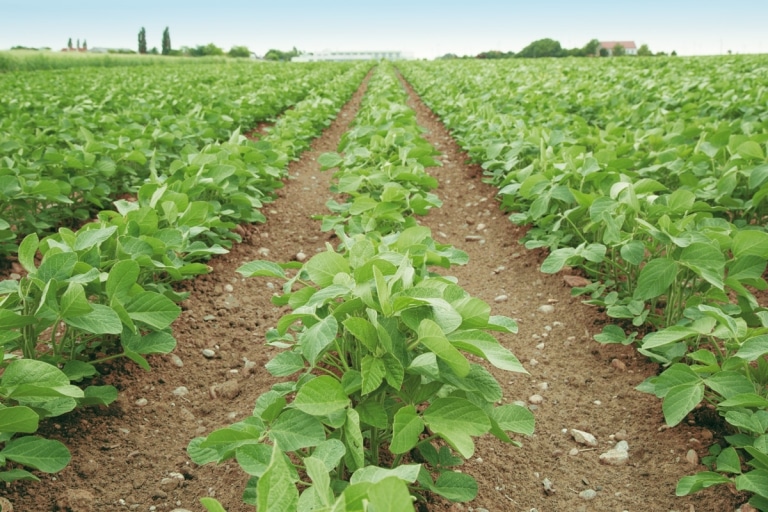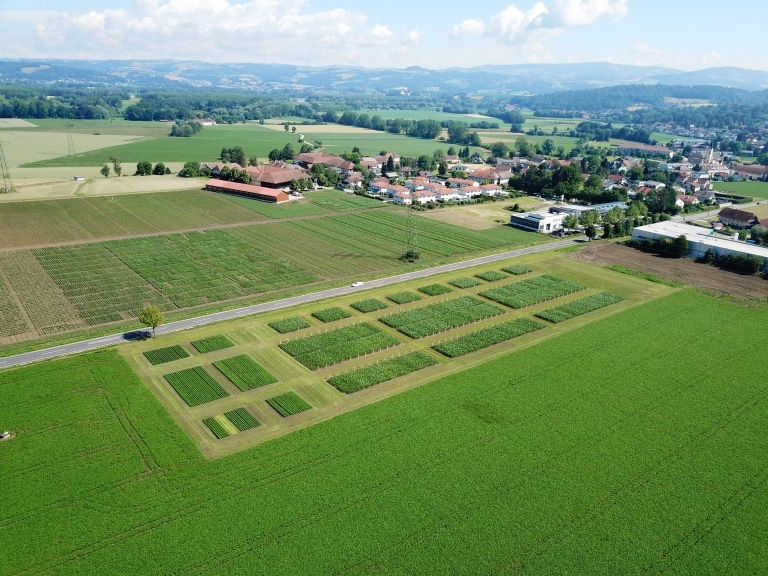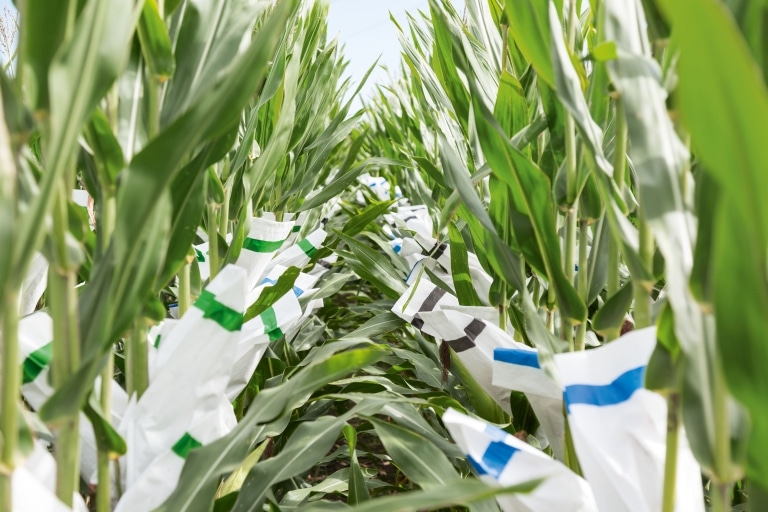29.06.2021
Precision farming with maize
Site specific crop management regarding sowing, fertilisation and plant protection is a topic which has gained importance in recent years as part of the wider topic of digitalisation. We are currently running trials at two sites in Austria as part of the ‘innovation farm’ framework.
We started trials for site specific sowing of maize in 2018. The growth of maize plants is closely linked to the availability of soil nutrients and soil water, which is why we recommend specific seed rates for all our varieties depending on the region, soil conditions and water supply. Maize plants can compensate environmental conditions by different yield components such as plant number, number of kernels per ear and TGW, so the recommended seed rate is always a product of full yield potential, drought tolerance and lodging resistance and the cost of the seeds.
The soil properties of a field are rarely homogeneous. A better water supply in one part of the field can transform a higher seed rate into significant yield increments. Lower seed rates on very dry parts of the field improve the stress tolerance and drought tolerance of the crop. Site specific sowing of maize allows significantly diversified crop density on the same field, adjusted precisely to the nutrient availability, soil properties and, which is especially important in dry areas, the capacity to store water (useable field capacity) of the individual field zones.
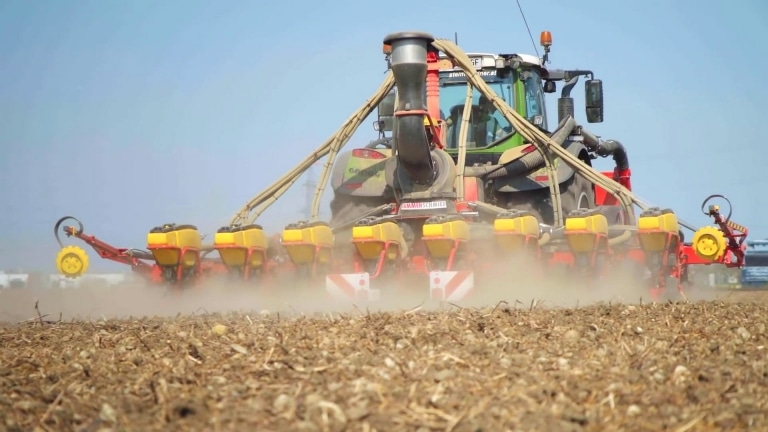
Trial sites
Two of our trials have been running for several years at two sites in Lower Austria, while new trials started at four new sites in 2020 as part of the Innovation Farm framework and in cooperation with Josephinum Research
The new trial sites in the Innovation Farm framework are located as follows:
- Grain maize early (SY CALO – FAO 250) in Hörsching near Linz at the Nöbauer farm;
- Grain maize medium early (DKC 3939 – ARNO® – FAO ca. 330) in Wieselburg in the framework of trials of Josephinum Research Wieselburg;
- Organic grain maize (DANUBIO – FAO 270) in Weiden am See in Burgenland at the Fuhrmann farm;
- Silage maize medium early (FILMENO – FAO ca. 290) in Waldhers in the northern Waldviertel region at the Hummel KG farm.
The following analysis presents the results of trials with grain maize late (FAO 390–420), because we already have results from the years 2018 – 2020 characterised by very different meteorological conditions. The sites are located in the dry zone of Lower Austria, in the Hollabrunn area at the operation Weinland Agrar GmbH (DI Patrick NOZ) in Guntersdorf and in the Neulengbach area at the Diesmayr farm in Umsee near Neulengbach. At both sites, we started trials with the maize varieties ARNAUTO® – DKC 4541 (FAO 390), ALBERTO® – DKC 4621 (FAO 410) und ABSOLUTO® – DKC 5065 (FAO 420) on several preferably inhomogeneous fields. For these trials, we selected varieties which carry our Klimafit-label, i. e. our most environmentally stable varieties with good stress tolerance and above-average yield capacities even under adverse conditions, especially heat and drought, but also excess precipitation.
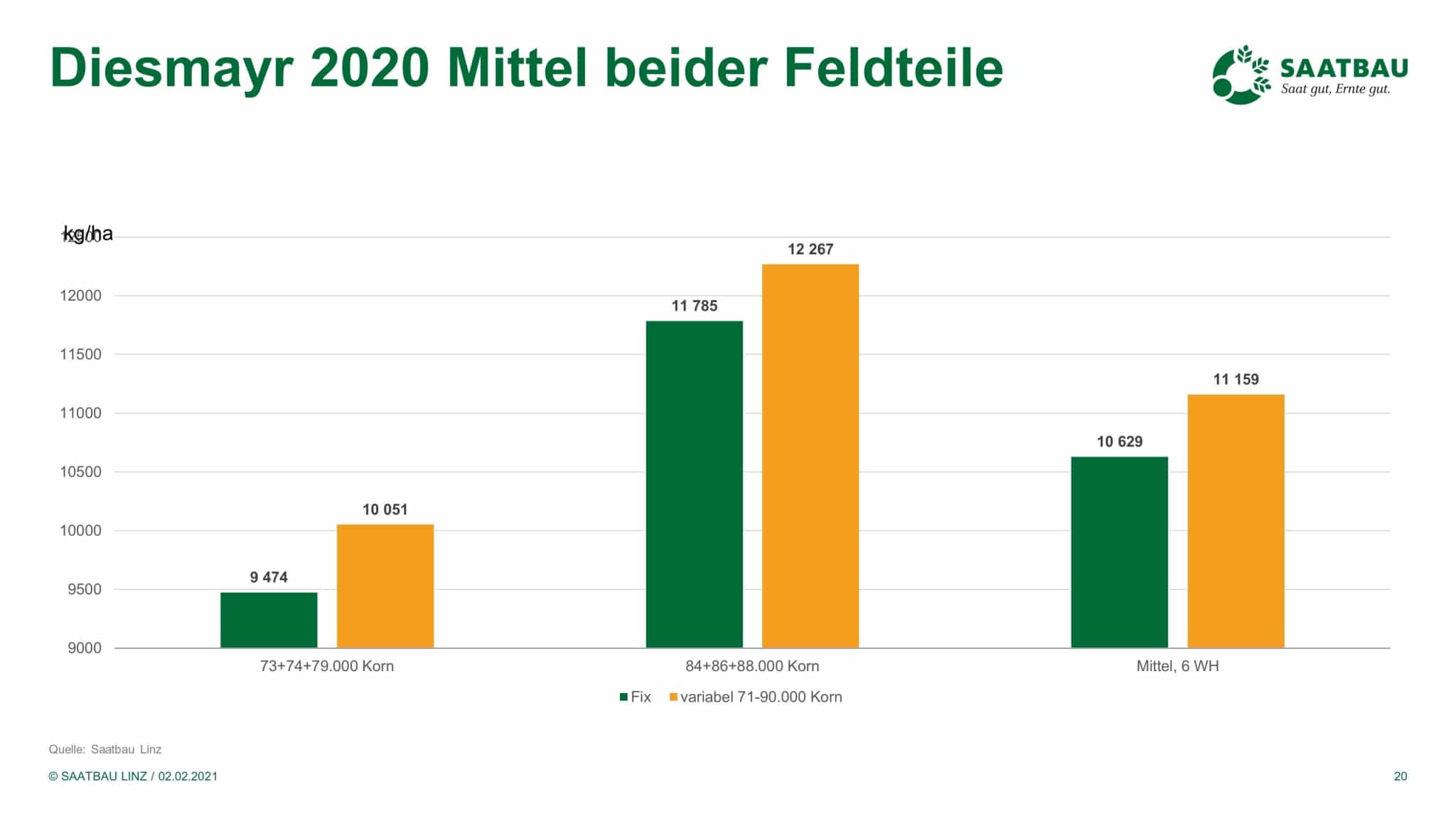
The trial set-up
Over the entire vegetation period, plots with site specific seed rates (according to the values from the application maps) are compared, observed and their yields analysed in autumn, in contrast with other plots with set seed rates. This comparison is subject to the condition that the same overall amount of seeds per hectare is sown on both the plots with site specific seed rates and the plots with a set seed rate. Therefore, the cost of seeds is the same for the farmer and profitability can be measured on the basis of the effect on the respective yield.
The amount of seeds per hectare is only adapted on the site specifically managed plot according to the application maps whereby the yield potential is adapted to the specific zone of the field. Depending on the year and the site, the trial variants were set out with up to six repetitions on the same field, with the individual site specifically managed plot being compared to the set variant plot located immediately next to it. The objective of these trials is to analyse the development of the overall yield, but also to find out how the crop reacts to a differentiated seed rate in different yield field zones. A condition for implementation on the field is the availability of the necessary sowing technology with electrically driven thinning elements, which allow variable sowing.
The trials were sown with a Väderstad Tempo, for the sites Hörsching and Wieselburg we thank subcontractor Steinwendner from Thalheim bei Wels, for Guntersdorf we thank the subcontractor Bogner from Etzersdorf and for Weiden and Waldhers farm-owned machinery was used. At the site Neulengbach an Accord Optima e-Drive was used.
Establishing application maps
Application maps are relative maps and show the relative yield potential of the plots in contrast to the average of the relevant zone of the field. These maps can be established either on the basis of one year or multi-annual satellite data (ESA’s Sentinel 2 satellites), as is the case at the Diesmayr farm, or from a variety of sources using the map overlay process (= establishing maps on the basis of soil maps, vegetation data, biomass maps from Sentinel 2 satellites, yield maps of previous years, data from soils sensors, …), as is the case at Weinland Agrar. The trials in the Innovation Farm framework use the sowing maps of geo-konzept.
Depending on the heterogeneity of the field, it is usually divided up into three to five different yield zones. Starting from a basic seed rate suitable for the better zones, a higher or lower seed rate is then determined for each of the different zones according to their classification.
The expertise of the map provider in cooperation with the farmer lies in the ability to filter out signal values and basic data from the flood of information available and from there, to make the right decisions for establishing the application maps.
Comparing the sowing map of the maize trial 2019 of Weinland Agrar (image sowing map maize 2019) with the aerial view of the wheat crop following the maize trial in May 2020 (image wheat crop on the same field in May 2020), it is clear, that the individual potential of the zones was accurately taken into account in the establishment of the map.
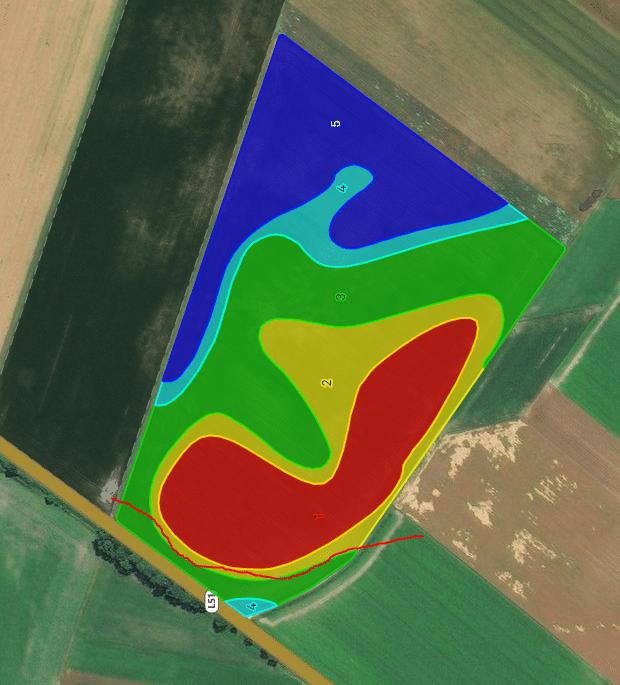
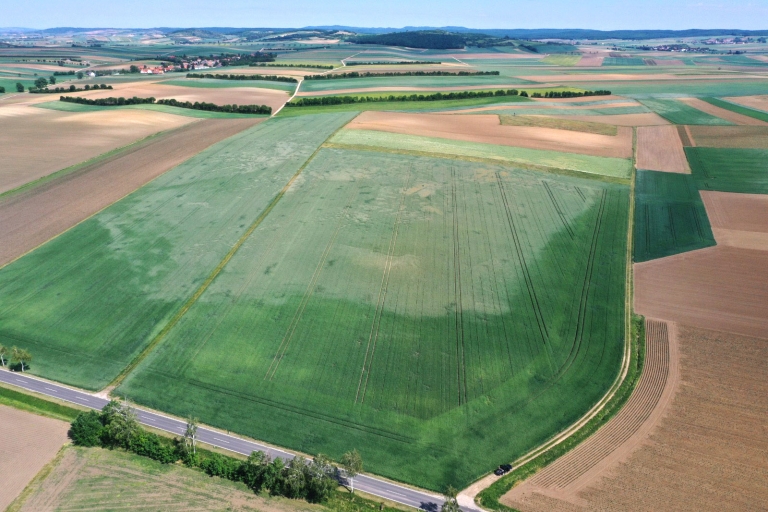
Trials, vegetation development and results
Guntersdorf site – Weinland Agrar GmbH: The trials were set up in 2018 with a set seed rate of 75,000 grains and a variable seed rate ranging from 60,000 to 90,000 grains, which results on average, in 75,000 grains per hectare. In 2019, due to the dryness of 2018, the same set up was complemented with a second variant with a set seed rate of 65,000 and variable seed rates between 60,000 and 90,000 grains and extended to a second field. In 2020, the set seed rate was consistently determined as the average of the sowing rates of the site specifically managed plots in the immediate vicinity (variations between 52,500 and 90,000 grains). This trial was carried out on the same trial field as in 2018. The variety sown in all the three trial years was ARNAUTO® (FAO 390). 2018 was very dry while 2019 and 2020 were very good maize years thanks to sufficient precipitation.
Neulengbach site: The trial at the Diesmayr farm was set up in 2019 and 2020 on the same field, by using set seed rates of 73,000, 74,000, 79,000, 83,000, 85,000 and 87,000 grains according to the soil quality, which were contrasted with variable seed rates ranging from 71,000 to 90,000 grains per hectare. For the set and variable variants to be compared, here, the same total amount of seeds per hectare was also used. Both 2019 and 2020 were good maize years with sufficient precipitation.
It is interesting to observe, that for the different trials, the relative yield increments vary between the years and sites (+2.6% to +5.3%), the absolute yield increments however are always between 300-530 kgs/hectare for the same seed cost.
The four trials (2 x grain maize, 1 x organic grain maize and 1 x silage maize) in the Innovation Farm framework are continuing in 2021 and the trial results will only be presented at the end of 2021, when the data for at least two years will be available. As a little sneak preview, we can already share that, in contrast to our expectations, the yield increment for the organic grain maize trial was very high, namely +9 %.019)
Conclusion
Many factors indicate, that digitalisation in agriculture is only starting and is already picking up speed. Many innovations are impressive, but not everything that is technically possible makes economic sense. Eventually, these new technologies must pay off, if they don’t, there is no added value – therefore, it is not the technology, but the advantages for you as a farmer that must be the focus of our efforts.
Yield increments through site specific adaptation of seed rates (at constant seed cost) are possible at the cost of significant investments in technology and work time. With our trials, we thus make data available on the reaction of varieties and on the economic viability of individual measures.
We wish you every success in your maize cultivation in 2021!
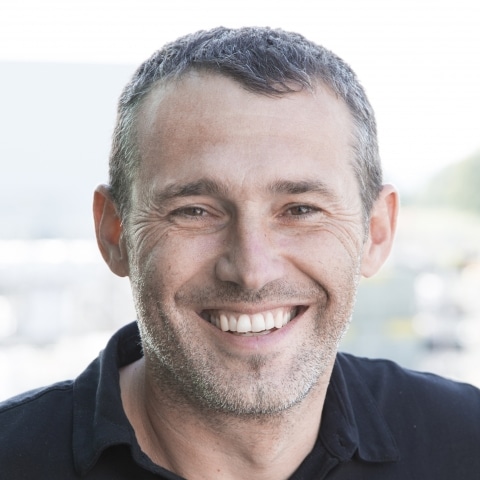
Albert MÜLLNER
Consultant crop farming
SAATBAU LINZ
You might also be interested in
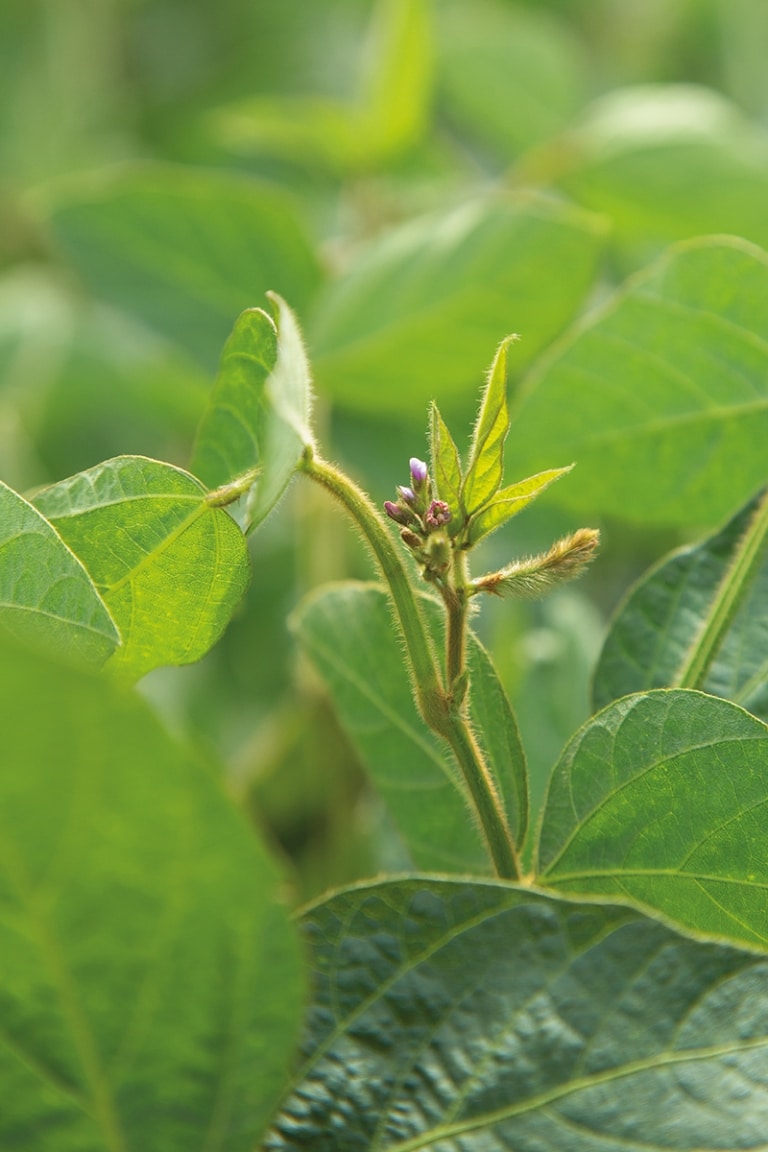
News
SAATBAU Germany’s Soybean Initiative
Interview with the managing directors on the new initiative
Mehr erfahren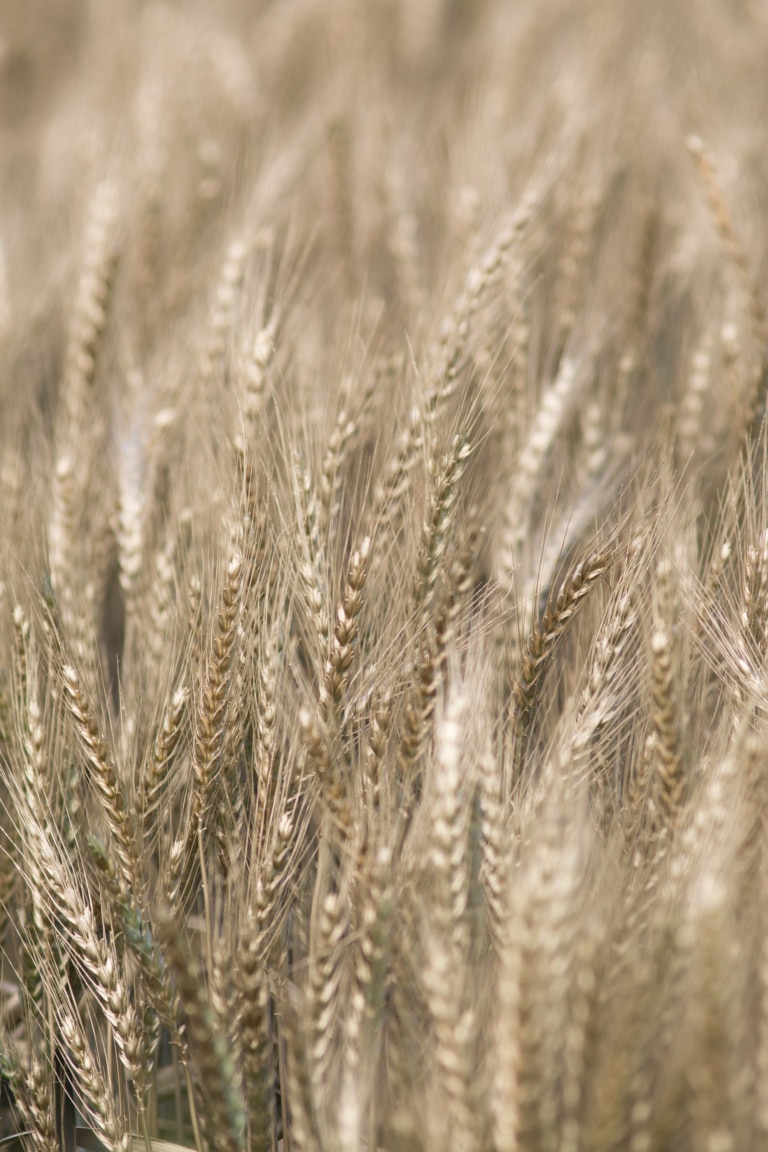
News
AURELIUS goes international
AURELIUS received its Austrian license in winter 2016. This was no surprise to us, but not…
Mehr erfahren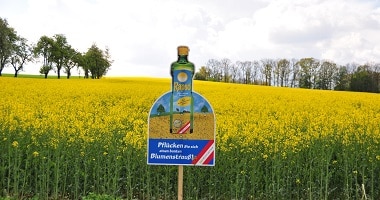
News
25 years RAPSO
The Upper Austrian chamber of agriculture and SAATBAU LINZ jointly developed the RAPSO project in order…
Mehr erfahren
News
Fine seeds becoming a delicious filling
The word “poppy” immediately makes Austrian’s think of the Lower Austrian Waldviertel region and the poppy…
Mehr erfahren